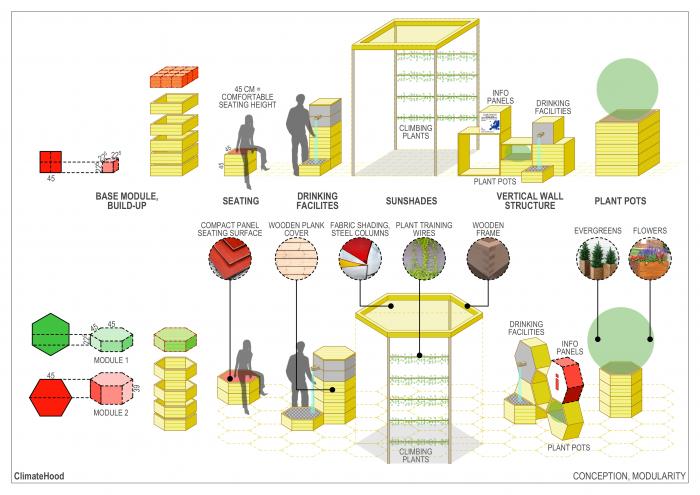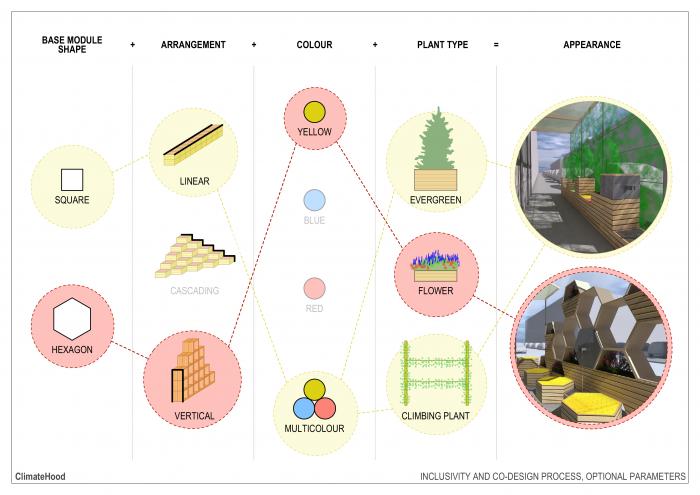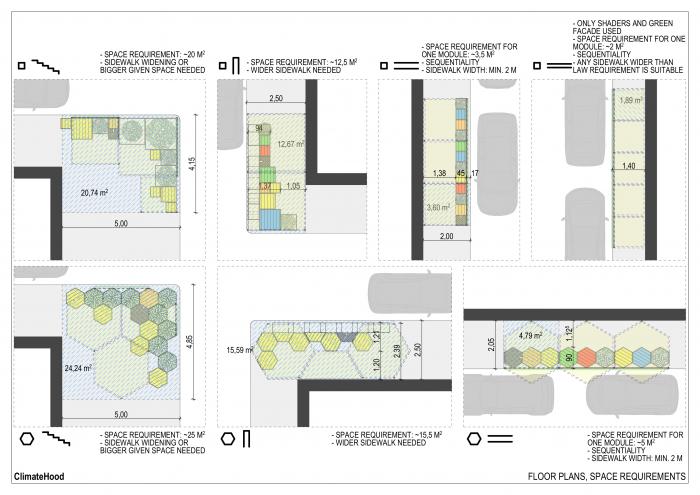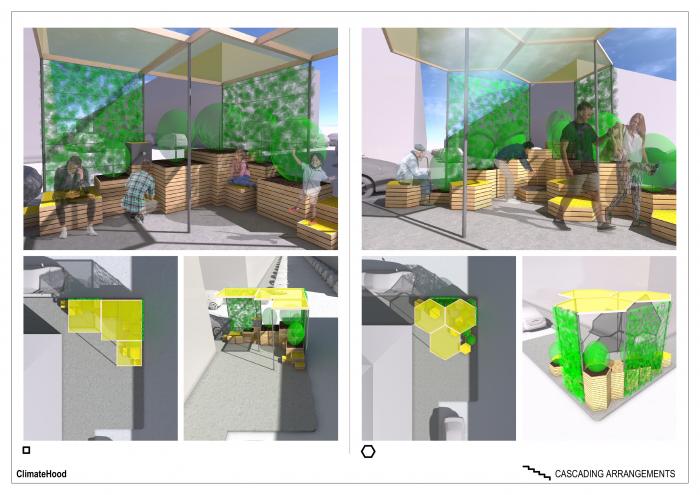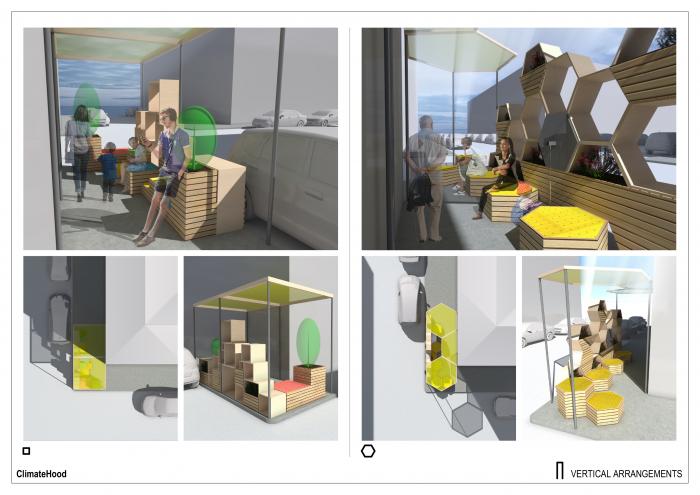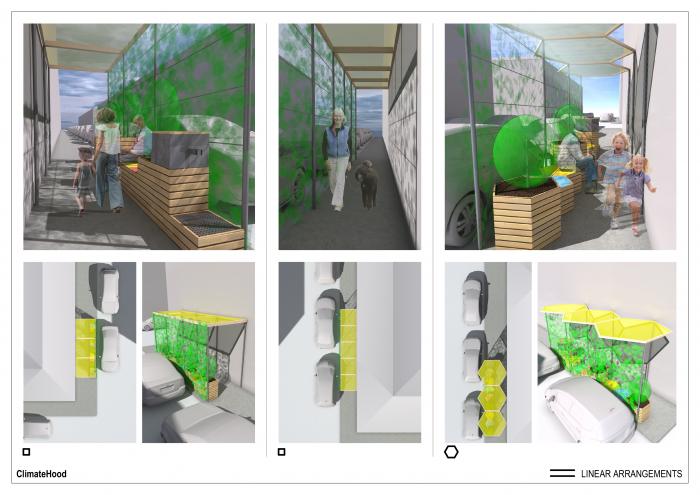CoolCo’s Cooling Corners and Corridors are small modular structures made from wood, fabric and steel to contain various plants and flowers. They are designed to reduce the impact of heat waves in urban areas, particularly densely populated neighbourhoods with low heat resilience. Their shape and size can be adjusted to fit strategic locations, sidewalks or walls for instance, where they provide refreshing “islands” of greenery to shelter inhabitants from the heat and improve air quality.
Our concept targets two main challenges of cities in the 21st century: Increasing climate change impacts and social inequality. We confront the threat of more frequent and severe heat waves by combining systemic adaptation and mitigation measures at the urban scale within existing infrastructure. Meanwhile, our approach is based upon community engagement and co-design, empowering disadvantaged groups to regain the transformative potential of their neighbourhoods and contribute to a fairer city.
Therefore, we facilitate the co-design and construction of “CoolCo’s: Cooling Corners and Corridors”, green refreshing islands in strategic locations of densely populated neighbourhoods with a low heat resilience. A main feature of the CoolCo’s is modularity. Different elements for heat mitigation and adaptation are combined to a unique corner or corridor which is adjusted to the existing infrastructure. These elements include seating modules, sunshades, drinking facilities, wall structures, plant pots and climbing plants.
The appearance of the CoolCo’s is thereby determined during the co-design process with stakeholders. Choices can be made in the base module shape (squared vs. hexagonal) and the overall arrangement being linear, for instance on sidewalks, cascading, in the case of street corners where more space is available, or vertical, providing additional shade. Further, participants of the co-design process can decide the colour of the modules and the type of plants to be used.
These predefined modules and shapes enable the stakeholders to become creative while they are easy to implement and to combine. As the modules can be adjusted to the surroundings, every space, no matter if only a few square metres, can potentially be transformed to a CoolCo. That is how the compact CoolCo’s function as a quick-win response given the urgent challenge of heat wave mitigation in cities.
Please highlight how the concept/idea can be exemplary in this context
The solution we propose contributes to environmental sustainability by tackling climate change through adaptation and mitigation at the same time. Recurrent urban heat waves are a major threat for European cities and are projected to increase in frequency and severity in the near future.
During heat waves, the CoolCo’s contribute to a cooler environment for the city's inhabitants, which means they can adapt better to the heat. On the other hand, the plants set up in the corners and corridors capture emissions, reducing the carbon footprint of the city and leading to better air quality.
The materials used in the CoolCo’s are selected with an emphasis on low-carbon impact and recyclability. Here, the modularity of the solution provides the advantage that individual modules can be replaced without having to rebuild the whole CoolCo. This ensures the efficient use of resources and the minimization of environmental impact.
Please highlight how the concept/idea can be exemplary in this context
Just as the original Bauhaus evolved in the 20th century with lightweight and natural materials and minimalistic design, the CoolCo’s will make use of simple and puristic materials like wood, steel and fabric. This sets the ground for a robust and timeless urban design in a modular fashion. Beyond their heat mitigating quality, the CoolCo’s enhance the livability in the surrounding areas through their aesthetic quality.
The philosophy of Bauhaus architects and designers was to improve the living conditions of people through art and design. This holistic approach is also translated to the CoolCo’s. Next to the health benefits resulting from the corners and corridors, our design concept also demonstrates that urban design solutions should not be a privilege for the better-off. Implementing urban design elements in deprived areas does not necessarily require large amounts of money, even small-scale interventions like the CoolCo’s can initiate change and point out that everyone is entitled to a livable environment.
Another key aspect of our concept is user-centric design. Every CoolCo will be designed and constructed in co-involvement of the stakeholders in the neighbourhood. This ensures that the elements of the corners and corridors are aligned with its surroundings and serve the needs of the users. Inhabitants are invited to interact with their environment and feel as part of it.
Last but not least, through the Cooling Corners, the threat of heat waves and the need for urban design to make changes gains visibility. Heat and heat impacts are often not tangible, and after a heat wave, the severeness of the impacts is easily forgotten. Our net of CoolCo’s will be a constant reminder of the threat of climate change and heat waves to the public, raising the sensibility for the topic and calling for further action on heat mitigation in cities.
Please highlight how the concept/idea can be exemplary in this context
Pursuant to the principles of the CoolCo’s concept everybody has the right to climate heat adaptation regardless of race, ethnicity, nationality, class etc. That right should be in parallel with the use of public space as well in order to ensure social and spatial equality. Therefore, we believe reclaiming public space for climate heat adaptation is a key element among vulnerable groups such as low-income households, elderly people, refugees, ethnic and national minorities, women, disabled persons, persons with chronic health conditions or persons working outside during heat waves.
A participatory approach is crucial, we build on our target groups’ insights, willingness and ability to undertake a collaborative designing process. That side of the concept contributes to the accessibility to urban design solutions for the vulnerable groups too. Residents will be involved in an experimentation lab process and later able to choose the localization of the corners and corridors (considering feasibility as well), the setup of the modules and the appearance of the final structure (see attached picture 02).
CoolCo’s are aimed to engage not just the citizens from the neighbourhood, but also other local stakeholders, such as non-profit organisations, local stores, and public institutions who are ready to provide a sort of protection during the hottest days. These sites might appear as possible refreshing sites on the Google Maps synchronised map, where all the CoolCo’s are marked and easily researchable.
Please highlight how this approach can be exemplary
The concept of CoolCo’s is based on inclusivity, sustainability and co-design. With the combination of those three aspects, Cooling Corners and Corridors can be created all over Europe's cities. With its emphasis on climate change adaptation, the CoolCo’s are a future-oriented approach to address heat impacts while being socially inclusive and providing an aesthetic value to their users. The appearance and the structure of the CoolCo’s can thereby be tailored according to the characteristics and existing urban infrastructure. Thus, narrow historical city centres in Southern Europe can have CoolCo’s just like the less dense centres of Eastern Europe. Thanks to European expansion and the New European Bauhaus initiative, inclusive heat adaptation practice and awareness-raising can become a part of Europe’s cities.
All in all, the design of the Cooling Corners is based on compactness, simplicity, minimalism, and community-driven construction. The method is replicable and scalable and adapts to the dwellers of the neighborhood, who know the needs of the community best.
The CoolCo’s, in accordance with the New European Bauhaus initiative, are co-designed and co-created urban spaces that are based on sustainability, creativity and social innovation. Our concept provides a unique approach of small-scale and low-cost urban design interventions for mitigating pressing heat impacts.
Quick-win
Cities will need to make tremendous changes to conquer the impacts of climate change, which will be a central challenge throughout the 21st century. However, this change requires time, sometimes years or decades. However, climate change impacts are already visible today and become constantly more pressing. The CoolCo’s present a solution which can be implemented within several weeks. Generally speaking, the corners therefore represent a “quick win” response towards tackling urban heat waves.
Modularity and Feasibility
The concept differs from being just a “green space” through integrating modules constructed with materials giving shade and a possibility for a small rest. The functionality of the corners and corridors is thereby explicitly aligned for the needs of pedestrians during heat. The variety of possible modules a CoolCo’s can exist allows for the individual adjustment of the concept to the existing infrastructure.
Transformative public space use
Differently from mainstream ideas related to public space usage, our initiative reclaims public space for creating just urban spaces giving the opportunity for heat adaptation for the most vulnerable groups. While today’s mainstream ideas do not deal with adaptation and mostly claim public space for sustainable mobility (such as for bike roads), recreation (carless streets, restaurants). The limited space within cities is used more efficiently, ecologically and socially sound.
For further development we have chosen Budapest as a pilot city, highlighting that heat weaves impose an enormous burden not just on the South but on Central Europe too. It's no longer a case of breaking a sweat: sustained high temperatures are literally life-threatening, with five heatwaves in 2015 claiming 1800 lives in Hungary.
In the capital of Hungary we aim to organise an urban experimentation lab in order to take on the task of creating relevant, reproducible, and place-based solutions to that specific social and environmental sustainability issue: heat adaptation. Our aim with the experimentation lab is to test our initiative in a real time and real life situation involving relevant stakeholders. Addressing strategic stakeholders helps us to engage the local community and neighbours in a participatory process to design each corner and corridor with features adjusted for each location.
The experimentation lab is planned in Józsefváros, one of the most deprived neighbourhoods in Budapest that can be described by the lowest green surface intensity, the highest population density and temperature in summer days. The targeted corner is in the corner of Víg and Bérkocsis street, as a strategic point given by the proximity of József Boulevard and Rákóczi téri Vásárcsarnok (Market hall), high urban density, and the vulnerability of the households nearby.
According to the plans, the first corner will be implemented before the summer of 2024.
Subsequently to this first cycle of CoolCo’s, the lessons learned are consolidated and its Do’s and Don’ts are condensed in a toolkit. This toolkit will provide sufficient information on the components of a Cooling Corner and the participatory process to its implementation in other cities and contexts. This will especially enhance the scalability of the concept and its impact in other cities around Europe.
In case our initiative will be awarded we will be able to have a strong base in relation to the experimentation lab and implementation phases.
Regarding the experimentation lab we are planning to organise it during the hottest days of the summer, in July-August in order to stimulate real conditions when heat adaptation is indispensable. Before the experimentation lab we have countless duties contacting stakeholders, local government representatives, and residents.
After the experimentation lab we adjust our conceptual plans and by the end of September 2022, we will be able to provide proposed versions of the setup of the elements that can be valued by the residents for two weeks. Once the received feedback is included in the concept, by the middle of October we will search for technicians who will be able to produce our products. By choosing the producer we make emphasis on sustainability, solidarity, responsibility regarding the local and the global environment.
After finding the producer that fits our expectations, we assume to have our first contracts with local governments and that the production activity can go further from winter 2022 until march 2023.
The following on-site implementation will go hand in hand with the online mapping of the CoolCo’s, so one can check out the nearest corner or corridor during the next heat wave. Additionally, the map will also show publicly available spaces with existing refreshment points like parks, public libraries, etc.
All these activities are accompanied with a communication campaign during the summer of 2022 which aims to raise awareness of the importance of heat adaptation, co-design and inclusivity. Another time the campaign focuses on Budapest, but at the same time concerns the possibilities which can also be implemented in other European cities.
@Ghira, 2022
Content licensed to the European Union.
